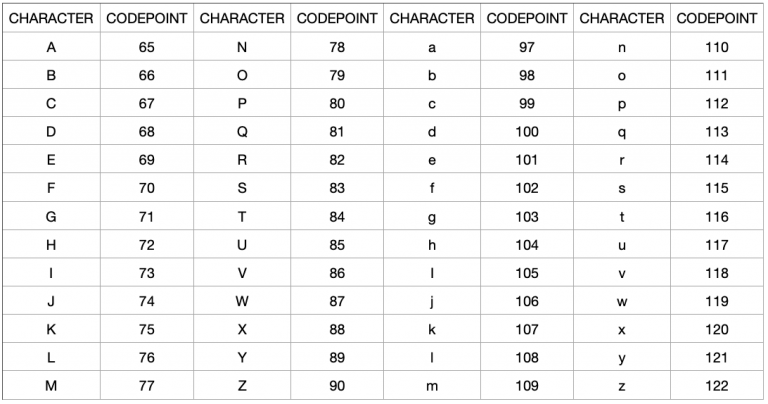- Leecode 2114. Max number of words in sentences
- 1528. Rearragne String
- Convert string to integer
- Convert integer to string
- Appendix
- Reference
- Future reading list
Leecode 2114. Max number of words in sentences
-
Problem: Given a list of sentences, find the maximum number of words of all the sentences.
-
Constraints: all lower case and no white space
-
Solution 1: Each sentence is an array of words separated with a space. The number of words is the number of space + 1.
-
Complexity:
def MaxWords1(sentences):
# i represents a sentence in the list of sentences
return max([i.count(' ') for i in sentences])
1528. Rearragne String
-
Summary: this problem is super easy. Just follow instruction and be careful.
-
Problem Input: s = “codeleet”, indices = [4,5,6,7,0,2,1,3] Output: “leetcode” Explanation: As shown, “codeleet” becomes “leetcode” after rearrange per indices.
def newArray(A, B):
res = []
for index, alph in enumerate(A):
res[B[index]] = alph
return res
It seems super easy to convert int to string or from string to int. Just use the int and str functions. The int function not only can
- convert a string to number
- convert using given base
- remove decimals from a floating number
int('10')
# 10
int('10', base = 2)
# 2
int(10.3)
# 10
But what if we want to implement those from scratch? We would need two Python functions that work with Unicode. According to Wikipedia, The Unicode Standard is an information technology standard for the consistent encoding, representation, and handling of text expressed in most of the world’s writing systems. In simple terms, Unicode is a universal standard for encoding characters and symbols. It does that by assigning a code point to every character and symbol in every language in the world.
ord() and chr() are inverses of each other.
ord converts a str character to its base-10 code point. A Unicode code point is a unique number assigned to each Unicode character. Examples: ord(‘0’) returns 48. ord(‘0’) returns 49. ord(‘a’) returns 97. ord(‘z’) returns 122.
chr is the inverse function of ord. Return a Unicode string of an integer. For example, chr(48) returns ‘0’. chr(49) returns ‘1’. Guess what, chr(97) returns ‘a’.

Convert string to integer
We can use the ord function, which returns the Unicode code point for a one-character string.
So we use ord(s) - ord(‘0’) to get the integer because integer 1 - 9 can be represented by their distance to ord(‘0’).
def string_to_int(s):
return ord(s) - ord('0')
def f(s):
res = 0
for i in range(len(s)):
num = string_to_int(s[i:i+1]) * 10**(len(s) - i -1)
res = res + num
return res
f('12')
# 12
But that only takes care of positive integers. We need to account for negative integers by checking if the first character is ‘-‘. If the beginning letter is the negative sign, then we need to start i at 1 instead of 0. Other than that, everything stays the same.
def f(s):
res = 0
if s[0] == '-':
start_index = 1
else:
start_index = 0
for i in range(start_index, len(s)):
num = string_to_int(s[i:i+1]) * 10**(len(s) - i - 1)
res = res + num
return -1*res if s[0] == '-' else res
print(f('12'))
# 12
print(f('-12'))
# -12
Convert integer to string
We need to take into account integers can be both positive and negative.
A string is a list of characters. We will
- convert the least signficant digit (using %10) to string.
- reduce current integer by //10 (to get the quotient 商)
- repeat the last two steps until the current integer is 0
- use .join() to glue the string together.
Because we want to append to the left, we will use a special list collections.deque. For example, for integer 12, the number 2 goes first, then 1. If we use append, the string would be ‘21’, the reverse of what’s expected.
And to convert a single digit integer to string, we use the chr function, which returns a Unicode string of one character with ordinal i; 0 <= i <= 0x10ffff.
When we write the function to convert input single string character to integer, we subtract ord(‘0’) from the Unicode of input by ord(s) - ord(‘0’). Conversely, we need to add ord(‘0’) when we want to go from Unicode to string.
from collections import deque
def single_int_to_string(x):
return chr(ord('0') + x)
def f(num):
s = deque()
while num:
s.appendleft(single_int_to_string(num % 10))
num //= 10
return ''.join(s)
print(f(12))
# '12'
type(f(12))
# str
Initially I used while num. But I think it is better to use while num > 0 explicitly.
Even though the code can be much shorter, but I think it is easy to understand and maintain to explicitly account for the case that input integer is zero, negative and positive.
from collections import deque
def single_int_to_string(x):
return chr(ord('0') + x)
def f(num):
if num == 0:
return single_int_to_string(0)
s = deque()
if num < 0:
is_negative = '-'
num = - num
else:
is_negative = ''
while num > 0:
s.appendleft(single_int_to_string(num % 10))
num //= 10
s.appendleft(is_negative)
return ''.join(s)
print(f(12))
# '12'
print(f(-12))
# '-12'
Appendix
Sometimes I like to add how to do things in SAS just so that I don’t forget too much. For reference, in SAS, to conver string to integer, we use
data new;
char_var = '123';
numeric_var = input(char_var, 8.);
run;
data new;
num_var = 123456;
char_var = put(num_var,6.);
run;
Reference
Stackoverflow: What’s the difference between a character, a code point, a glyph and a grapheme?
ReaPython: Python Encoding Guide
Learn Coding Fast: 2 ways to convert a string to lowercase in python